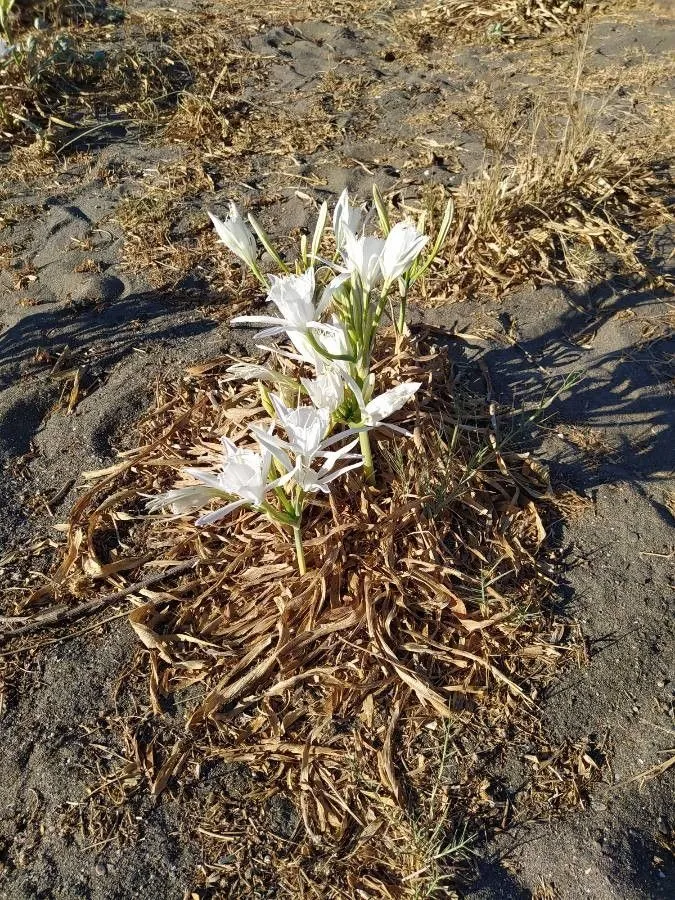
Author: L.
Bibliography: Sp. Pl.: 291 (1753)
Year: 1753
Status: accepted
Rank: species
Genus: Pancratium
Vegetable: False
Observations: Canary Is. (Fuerteventura), Medit. to Black Sea coast
The sea-daffodil, known scientifically as Pancratium maritimum, is a captivating plant that belongs to the Amaryllidaceae family. Its presence is predominantly noted in regions stretching from the Canary Islands, specifically Fuerteventura, all the way to the Mediterranean and the Black Sea coast.
First described in 1753 by the eminent botanist Carl Linnaeus, Pancratium maritimum has since garnered much admiration for its enchanting beauty and unique ecological adaptations. This perennial plant thrives in sandy and saline environments, often gracing coastal dunes and shorelines with its pristine, white blossoms.
Characterized by its elongated, strap-like leaves, the sea-daffodil emerges from a bulbous base, which stores the necessary nutrients to survive the harsh, arid conditions of its native habitats. As summer approaches, this resilient plant produces a stunning display of star-shaped flowers, each exuding an exquisite fragrance that attracts a variety of pollinators.
The flowers of the sea-daffodil are particularly noteworthy for their intricate structure. Each bloom consists of six tepals that delve into a delicate central cup, known as the corona. This sophisticated arrangement not only adds to the plant’s visual appeal but also plays a crucial role in its reproductive success.
Despite its tough habitat, the sea-daffodil faces several threats, including coastal development and climate change, which pose risks to its natural habitats. Conservation efforts are essential to ensure the survival of this majestic species, allowing future generations to marvel at its elegance and resilience.
In summary, Pancratium maritimum, or the sea-daffodil, is a botanical gem that stands as a testament to nature’s adaptability and beauty. Its fragrant, white flowers and hardy leaves make it a symbol of endurance and grace along the coastal terrains it inhabits.
Eng: sea daffodil, sea-daffodil
Swe: strandlilja
Cym: cenhinen-bedr dyfnaint
En: Sea-daffodil, Sea Daffodil, Sand Lily
Ar: زمبق (زَمْبَق), سوسن (سَوْسَن، سُوسن)، بصيل (بُصَيْل), طيطان بحري
Hy: Ծովանարգես
Eu: Itsas lilipa
Bg: Пясъчна лилия
Ca: Lliri de mar, Assutzena d’arenal, Lliri d’arenal, Lliri marí
Co: Gigliu di mare
Cs: Lír přímořský
Nl: Strandnarcis
Et: Rand-vägilill
Fi: Hietamerinarsissi
Fr: Lis maritime, Lis de mer, Lis des sables, Lis matthiole, Lys de mer, Lys des sables, Lys maritime, Lys mathiole
Ka: Ზღვის შროშანი
De: Dünen-Trichternarzisse, Meerstrands-Gilge, Strand-Pankrazlilie
El: Κρίνος της θάλασσας
He: חבצלת החוף
It: Giglio marino comune, Giglio marino
Fa: پانکراتیوم ماریتیموم
Pl: Pankracjum nadmorskie
Pt: Lírio-das-areias
Ru: Панкраций морской
Es: Azucena de mar, Pancracio, Azucena marina, Nardo coronado, Nardo marino
Sv: Strandlilja
Tr: Kum zambağı
Cy: Cenhinen-Bedr Dyfnaint
Taken Sep 13, 2017 by Ladislav Stoupa (cc-by-sa)
Taken Dec 8, 2002 by Joachim Schade (cc-by-sa)
Taken Sep 26, 2017 by Miguel Angel (cc-by-sa)
Taken Oct 3, 2016 by Leonhard Schlimm-Koppe (cc-by-sa)
Taken Apr 3, 2019 by Pedro Escudero (cc-by-sa)
Taken Nov 20, 2022 by Patrick Prevost (cc-by-sa)
Taken Jul 27, 2022 by Monika Opočenská (cc-by-sa)
Taken Aug 17, 2020 by Gangutia David (cc-by-sa)
Taken May 1, 2022 by Daniel Bourget (cc-by-sa)
Taken Aug 17, 2021 by Alexandre Thiebault (cc-by-sa)
Taken Sep 28, 2021 by Nathalie Potel (cc-by-sa)
Taken Sep 9, 2021 by Sergey Shatrov (cc-by-sa)
Taken Nov 11, 2021 by Monika Monika M (cc-by-sa)
Taken Nov 11, 2021 by Monika Monika M (cc-by-sa)
Taken Nov 11, 2018 by Providence Roche (cc-by-sa)
Taken Dec 14, 2021 by Chickpea (cc-by-sa)
Taken Nov 3, 2021 by rens rens (cc-by-sa)
Taken Nov 15, 2021 by Lorenzo vita (cc-by-sa)
Taken Jan 3, 2021 by Salvador Maria Paula (cc-by-sa)
Taken Jul 27, 2021 by Raphaël (cc-by-sa)
Taken Jul 24, 2022 by D. Manuel (cc-by-sa)
Taken Jul 23, 2022 by Jacques Roif (cc-by-sa)
Taken Jul 14, 2007 by Martin Bishop (cc-by-sa)
Taken Aug 25, 2020 by alessadro brign (cc-by-sa)
Taken Sep 8, 2019 by Gilles Bigi (cc-by-sa)
Taken Aug 13, 2022 by manumanu4691 (cc-by-sa)
Taken Aug 6, 2021 by Álvarez Héctor (cc-by-sa)
Taken Oct 15, 2011 by Photoflora – Benoit BOCK (©)
Taken Aug 22, 2020 by maire sofia (cc-by-sa)
Taken Aug 21, 2021 by Marek Durajczyk (cc-by-sa)
© copyright of the Board of Trustees of the Royal Botanic Gardens, Kew.
© copyright of the Board of Trustees of the Royal Botanic Gardens, Kew.
© copyright of the Board of Trustees of the Royal Botanic Gardens, Kew.
Growth habit: Forb/herb
Bloom months: [‘jul’, ‘aug’, ‘sep’]
Family: Myrtaceae Author: (F.Muell.) K.D.Hill & L.A.S.Johnson Bibliography: Telopea 6: 402 (1995) Year: 1995 Status:…
Family: Rubiaceae Author: Pierre ex A.Froehner Bibliography: Notizbl. Bot. Gart. Berlin-Dahlem 1: 237 (1897) Year:…
Family: Sapindaceae Author: Koidz. Bibliography: J. Coll. Sci. Imp. Univ. Tokyo 32(1): 38 (1911) Year:…
Family: Asteraceae Author: A.Gray Bibliography: Pacif. Railr. Rep.: 107 (1857) Year: 1857 Status: accepted Rank:…
Family: Fabaceae Author: Medik. Bibliography: Vorles. Churpfälz. Phys.-Ökon. Ges. 2: 398 (1787) Year: 1787 Status:…
Family: Aspleniaceae Author: (Cav.) Alston Bibliography: Bull. Misc. Inform. Kew 1932: 309 (1932) Year: 1932…